Why is Smoke a Health Concern?
Wildfire smoke contains PM2.5 that can be easily inhaled and lead to a range of health effects that have been well established by decades of research on ambient PM2.5 exposures (i.e., exposures experienced outdoors during a typical day, not during an extreme event like a wildfire) (U.S. EPA 2019; U.S. EPA 2021).

Source: Aimen Farraj
When assessing the potential health implications of PM2.5, it is important to understand how exposure to particles can lead to health effects. This requires an understanding of the intake, deposition, retention and translocation of particles within the body, which is referred to as particle dosimetry. The dose of inhaled particles and the number of particles that are deposited and retained in the respiratory tract depend on:
• particle concentration and exposure duration,
• physical activity level and breathing conditions
(e.g., nasal vs. oronasal breathing) and
• particle properties (e.g., particle size,
hygroscopicity, solubility in airway fluids).

response to PM2.5 exposure.
Source: Adapted from Brook et al. (2010)
Dosimetric evidence shows where PM2.5 can go in the body once inhaled, with smaller particles able to reach the lower regions of the respiratory tract (Figure 2). This line of evidence is important because it further informs toxicological studies that demonstrate the biological pathways by which PM2.5 exposure can ultimately result in the health outcomes reported in epidemiologic studies (e.g., respiratory- or cardiovascular-related emergency department [ED] visits or hospital admissions). Dosimetry studies show that once inhaled, PM2.5 can elicit health effects through three primary pathways (Figure 3):
- inflammation and oxidative stress,
- perturbations of the autonomic nervous system, and
translocation of particles from the alveolar region of the respiratory tract to the blood, where they can affect other organ systems, such as the heart (U.S. EPA 2019).
